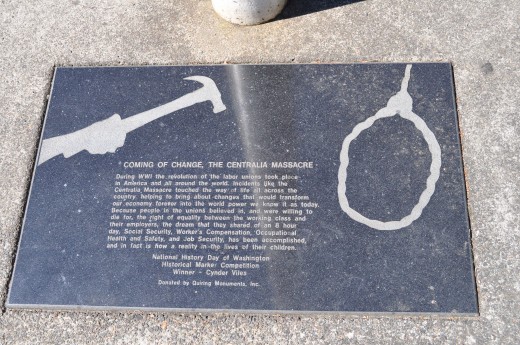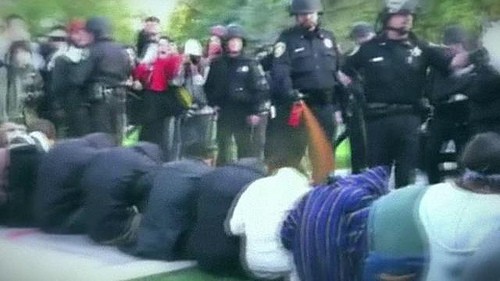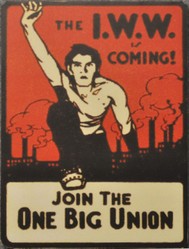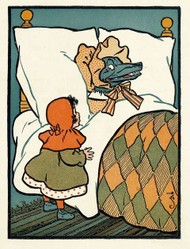Back in November 11, 1919, the lumber companies had great power and stake in the land and timber of Washington State. At the same time, the IWW, with their radical perspective on the social and economic system, began to organize lumber workers in the state who were working long arduous hours at low pay. World War One had just ended, and there was much patriotic fervor in America, simultaneously there was a brand new Red Scare and fear of the recent Bolshevic Revolution that had occurred in Russia. Capitalizing on all this, the lumber industry leaders took advantage of fear and patriotism and encouraged vigilante attacks on labor, labeling labor activists as Communist and unpatriotic. War abroad often has effects here at home.
To go back further, to lay the groundwork for understanding what led to events in 1919, we must go back to 1916, to Everett, Washington, where 40 Wobblies were taken out of the local jail by deputies, turned over to vigilantes and brutally beaten. At that time, it was common for Wobblies to be taken and forced to "run the gauntlet", being beaten by local vigilantes, and sometimes even lynched. After the incident of Wobblies being attacked by vigilantes, Wobbly support from Seattle, 250 strong, decided to sail to Everett to stand in support of the workers there; they were met by 200 newly-deputized men, and an exchange of gun-fire ensued, killing 5 Wobblies and 2 deputies, wounding 30, and an unknown number of Wobblies died jumping ship. Upon return to Seattle, the Wobblies faced criminal charges for the incident, but none were convicted.
Forward to 1918, in Centralia, Washington, the IWW union hall was raided by the lumber-industry-backed American Legion; Wobblies were chased out and beaten. Such on-going brutality against the Wobblies was recurring, including the beating of a blind man named Tom Lassiter who sold Wobbly periodicals from his news-stand; he was taken across county lines and abandoned by a group of vigilantes.
It should be stated that by 1919, the labor movement, with the Wobblies heavily active in it, was in full swing; earlier that year, there had been a general strike in Seattle, with 65,000 labor activists involved, which shut down the city for several days. So, the lumber barons, and their cohorts in the American Legion, were prepared to finish off the Wobblies once and for all. F.B. Hubbard was head of the Eastern Railway and Lumber Company and president of the Employers' Association, a man who controlled much of the land, business, and media of Centralia, in addition to having an ally who was head of the local Farmers' and Merchants' Bank: Hubbard and other businessmen had created and organized the Citizens Protective League, of which Hubbard was the head, an organization which was made up of the police, the Elks Lodge, and the American Legion. In October of 1919 the League formulated a plan to attack the IWW union hall on November 11, 1919 during the Armistice Day Parade, intentionally drawing the map of the procession to pass the union hall.
The Wobblies, having had too many experiences of being attacked and brutalized, consulted their lawyer Elmer Smith, who told them that they did have a right to defend themselves.
So, the war veterans took the rear of the parade procession; as the march reached the union hall, it stopped, the American Legion, carrying coils of rope and weapons and at that point in front of the union hall but the tail of the parade procession, did an about-face, and charged the union hall; shots were fired from inside the union hall and from another location outside the hall; head of the American Legion, Walter Grimm (who replaced the former leader of The Legion who was against the raid, a man named William Scales) was shot and later died from the wounds; in the end, officially, 6 people were killed, 4 from the American Legion (including Dale Hubbard, nephew of lumber baron, F.B. Hubbard) and Wesley Everest, Wobbly and World War One veteran who had vowed that since he had fought for democracy in France then he would also do so at home in America.
The murder of Everest was a grisly example of vigilante "justice". He had escaped out the back door of the union hall during the incident, gun in hand, and was chased by the mob; Dale Hubbard leveled his weapon to shoot Everest but the Wobbly got the Legionnaire first; still, the mob overtook Everest, tied him by the throat and dragged him to jail; in the evening, they kidnapped him from the jail, took him to a bridge, lynched him and his dangling body was shot full of bullets, while his Wobbly brothers were left at the jail to be tortured for their confessions.
Seven Wobblies were convicted due to this incident, however no one was convicted for the murder of Wesley Everest or for attacking the union hall. Years later, when jurors knew the whole story, they admitted they would not have convicted the Wobblies, and admitted they were intimidated by the many veterans who filled the courthouse and who even camped on the courthouse lawn during the trial. A Legionnaire named Edward Bassett said the Legionnaires had behaved disgracefully and the Wobblies were justified in their self-protective actions. In 1929, The Centralia Publicity Committee issued a statement by Legionnaire and Army Captain Edward Patrick Hall, saying that an injustice had been committed against the Wobblies, that the Legionnaires had been duped and used by the lumber business interests, and the Wobblies who were imprisoned ought to be released. In the early 1930s, 5 of the Wobblies who had been convicted were paroled and, several years after those Wobblies were paroled, the rest, having refused parole (insisting on pardons), were released from prison after sentences were commuted to time served.






 Why Are My Veins So Visible?on 07/15/2020
Why Are My Veins So Visible?on 07/15/2020
 Should Female Backpackers Go on their Own? Why or Why Not?on 07/15/2020
Should Female Backpackers Go on their Own? Why or Why Not?on 07/15/2020
 Why Do BPD Women Lie?on 07/15/2020
Why Do BPD Women Lie?on 07/15/2020
 Why Do My Joints Hurt?on 07/15/2020
Why Do My Joints Hurt?on 07/15/2020


Comments